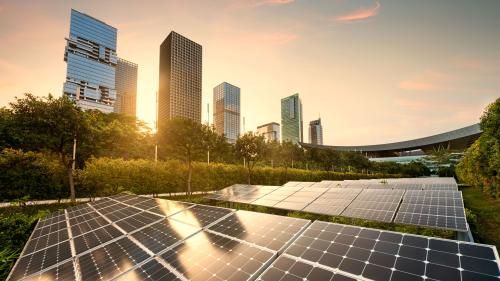In a letter to CEOs earlier this year, Larry Fink, chairman of BlackRock—the world’s largest asset manager—spoke about a “tectonic shift in the global allocation of capital,” emphasizing climate change as a growing investment risk but also pointing to the climate transition as a historic investment opportunity. With BlackRock’s almost $9 trillion in assets under management, Mr. Fink’s views are likely to have an outsized impact on financial asset allocation. If Wall Street heeds his vision, this could well prove to be a game-changer in global efforts to reduce climate risks.
But when it comes to mobilizing capital for green investment there is an even bigger game in town. Just weeks after Mr. Fink issued his letter, Chinese Premier Li Keqiang emphasized the development of green finance as a key government priority during the “two sessions”—the annual back-to-back meetings of China’s major political bodies. China not only accounts for almost one-third of global greenhouse gas emissions, its financial system is also the second largest in the world. Fueled by exceptionally high domestic savings—at about 45 percent of GDP China’s savings rate is among the highest in the world—its largely state-dominated banking system alone has accumulated assets worth almost $50 trillion. Increasing the share of financing to green investment even by a fraction of these vast financial resources could go a long way in the transition to greener growth—both within China and abroad.

Already today, China’s green finance markets are touted as the world’s largest. In the first quarter of this year, Chinese issuers sold green bonds worth $15.7 billion, overtaking the U.S. as the largest market for green bonds. Meanwhile, outstanding green loans of Chinese banks amounted to almost 12 trillion yuan ($1.8 trillion) at the end of last year, according to data from China’s central bank, making it the largest green loan book in the world (Figure 1). Despite this, green assets still account for only a fraction of China’s financial market with green loans and bonds making up less than 7 percent and 1 percent of their respective totals. Green equity markets, especially early-stage risk capital necessary to spur innovation, also remain relatively shallow.
Achieving China’s goal of carbon neutrality by 2060 will require significant capital flows into the development of low-carbon infrastructure. A recent study by Tsinghua University’s Institute for Climate Change and Sustainable Development estimates, for example, that new investments of around 138 trillion yuan ($20 trillion) will be needed between 2020 and 2050 in the energy system alone to achieve the carbon neutrality target. A faster transition path both in China and the rest of the world would likely generate additional investment demand including through the accelerated depreciation of existing carbon assets and by stimulating green innovation and technology upgrading.
Increasing the share of financing to green investment even by a fraction of these vast financial resources could go a long way in the transition to greener growth—both within China and abroad.
What will it take to accelerate the reallocation of Chinese ample domestic savings toward greener investment? For starters, the government itself remains a large user of capital. But despite some green sprouts, government investment in China remains largely brown. According to an assessment carried out by Vivid Economics, brown measures far exceeded green investments in the fiscal recovery package adopted last year. Nowhere is the transition toward greening more important than in the energy sector. A cap on domestic coal consumption and installed coal-fired power plant capacity would make a major contribution to helping China peak carbon emissions well before 2030. The corresponding increase in renewable capacity, battery storage, and the investment in smart grids will continue to require large-scale public and private financing as well as strong policy commitment.
Green finance standards are one critical element of creating an enabling environment. Importantly, China last year removed clean coal from the green investment list but there are still areas where Chinese standards deviate from international practice. For example, at 50 percent of the total investment, the required share of certified green investment is much below the 95 percent threshold in international green bond standards. In addition, environmental risk management and information disclosure could also be enhanced. While necessary, these interventions to develop the supply of green finance alone will not be sufficient to encourage the reallocation of assets at the scale and pace required to achieve China’s emission reduction targets. Stimulating the demand for green financing is equally if not more important. Adjusting relative prices to adequately reflect the social cost of carbon—either directly through carbon taxes or indirectly through tradable emission rights—would lower the returns to carbon-intensive investments while boosting those of low-carbon assets.
Finally, as important as the greening of China’s domestic financial markets is the question of what Chinese savings finance abroad. China is one of the largest investors and creditors to many developing countries. Dirty investment has dominated much this outbound financing, especially in the energy sector. But the share of financing for renewable energy has been rising in recent years and last year exceeded fossil fuel-related investment (Figure 2). On the policy front, the recently adopted Climate Finance Guidance, which states that China aims to “regulate offshore investment and financing activities,” could signal a shift toward the adoption of environmental standards for China’s external lending. As part of this initiative, China could—like other major creditors—consider a moratorium on the financing of coal plants and other fossil fuel assets overseas. Finally, given elevated debt distress risks in many low-income countries, debt for nature swaps could be part of potential sovereign debt restructurings that will become necessary post-COVID-19.
 In a previous blog, we argued that the secular decline in the natural rate of interest across most advanced economies created an opportunity to direct surplus savings into climate action at historically low costs. In China interest rates have not fallen by as much, mainly because China absorbs its extraordinarily high savings through state-led investment. Going forward, instead of ploughing more savings into traditional assets that are already only marginally productive, China could harness the drive to lower emissions with a decisive shift in the allocation of capital into green investment. This would allow China to green and grow its economy at the same time, steering it into a future that is both prosperous and sustainable. Like other major economies, it should not let the opportunity pass.
In a previous blog, we argued that the secular decline in the natural rate of interest across most advanced economies created an opportunity to direct surplus savings into climate action at historically low costs. In China interest rates have not fallen by as much, mainly because China absorbs its extraordinarily high savings through state-led investment. Going forward, instead of ploughing more savings into traditional assets that are already only marginally productive, China could harness the drive to lower emissions with a decisive shift in the allocation of capital into green investment. This would allow China to green and grow its economy at the same time, steering it into a future that is both prosperous and sustainable. Like other major economies, it should not let the opportunity pass.
The Brookings Institution is committed to quality, independence, and impact.
We are supported by a diverse array of funders. In line with our values and policies, each Brookings publication represents the sole views of its author(s).









Commentary
How China’s savings could help save the planet
April 22, 2021